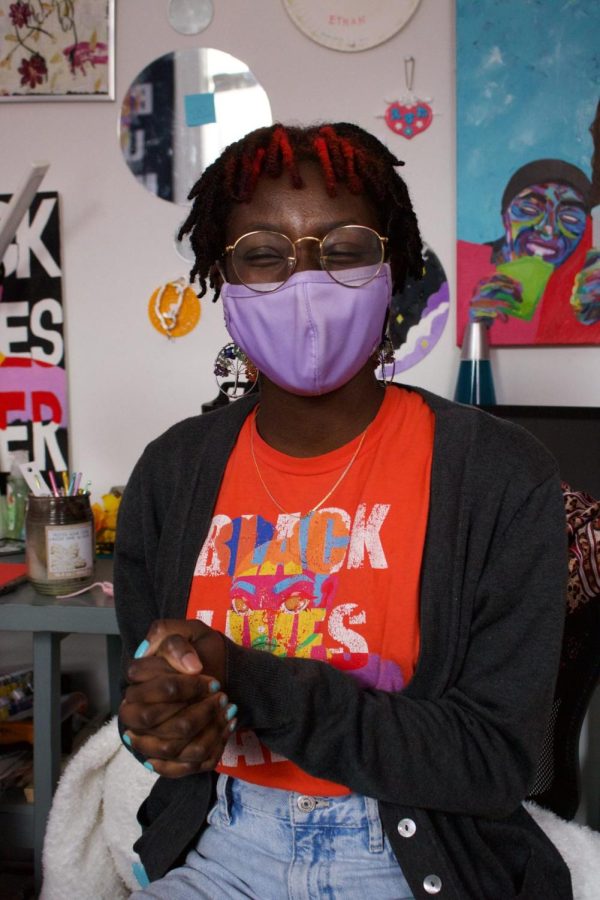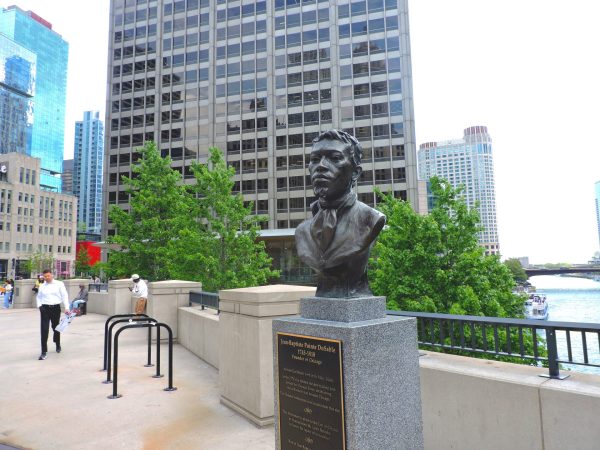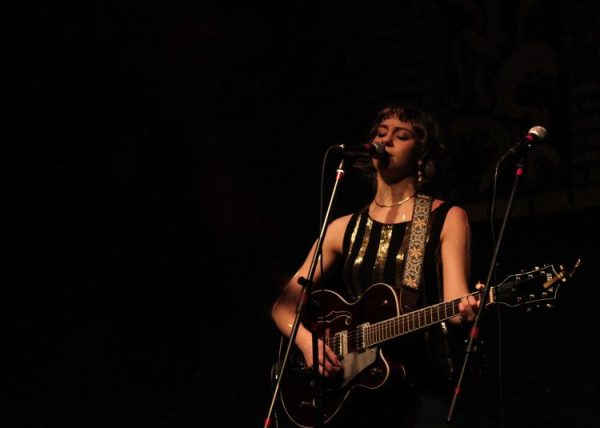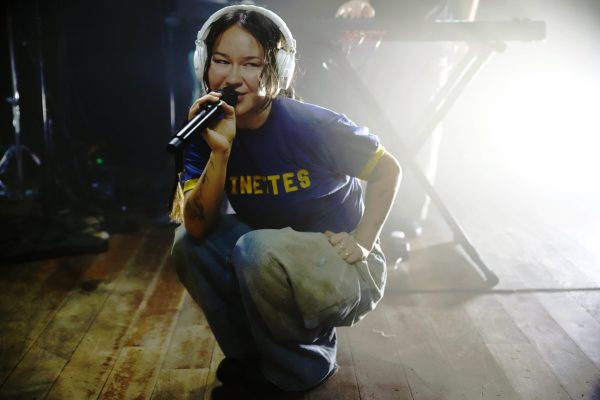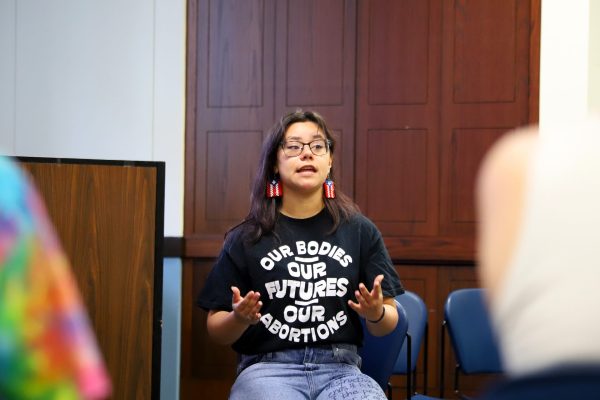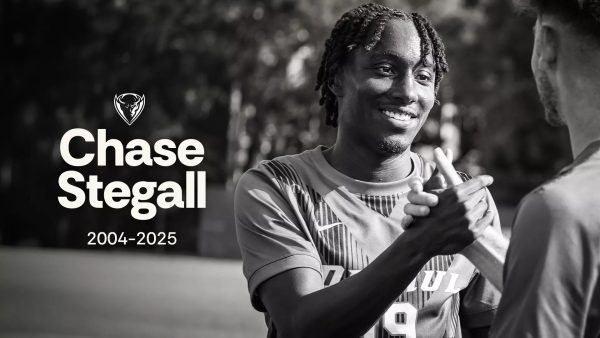The future of art is Black
Alison Schultz for The DePaulia
Esther Ajayi, a senior at DePaul studying Animation.
Esther Ajayi, a senior at DePaul majoring in animation, runs around the room showing off her sketchbooks full of doodles and Black characters, pulling more art from underneath the bed to expose layers of charcoal sketches and oil paintings tucked away. There are acrylic paintings on canvases, denim jackets with handmade cartoon designs and digital art with the words “Black Lives Matter” displayed proudly on her walls.
Ajayi has been creating art since she was a kid with her parents’ continuous support for her creativity. While her major is in animation, she also does traditional and digital art as well as clothing designs.
“Both of my parents are extremely creative, my dad would doodle with me and encourage me to draw all the time,” Ajayi said.
In addition to creating, Ajayi sells her art as well. Before the pandemic started, she contributed to the Black Artists Spotlight and was grateful for the opportunities provided to help display her art.
“DePaul was extremely supportive back in 2019,” Ajayi said. “Black Artists Collective hosted a show and I submitted one of my denim jackets for the art show. It was an amazing experience and I got to meet so many Black artists because of it and work and model with them.”
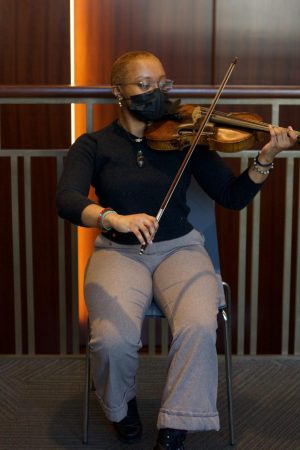
DePaul has a rich history of art, and this year has deepened that tradition. From theater to music to digital comics, DePaul students have found different ways to express their creativity and to channel their art into a future of self expression and discovery. At a school with just 39 percent students of color — the highest number it’s ever been — it is crucial to bring light to a common issue at most predominantly white schools; the issue of inclusion for creative Black students.
DePaul enrolled 2,072 African-American students, about 9.2 percent of the student population for the 2021-2022 school year, according to Data USA . Even with that number, DePaul’s race and ethnicity demographic is considered above average, ranking 600 out of 3,790 universities in the United States.
DePaul senior Michelle Manson studies viola performance and psychology and hopes to use these skills in the future to teach and perform. Manson has been a part of DePaul’s School of Music for the past four years, and while she enjoys her experience, being one of the few Black musicians at the School of Music holds a lot of pressure.
“DePaul is a very white school and it feels like you have to represent all the time, which means I have to be on all the time,” Manson said. “Which is so tiring. It’s exhausting to be on all the time. And if you’re not on, then people stop paying attention to you.”
Growing up, Manson had support from her parents as they were also musicians and wanted her to succeed. Throughout her childhood, there were multiple occasions where Manson felt she didn’t get the recognition when other students did.
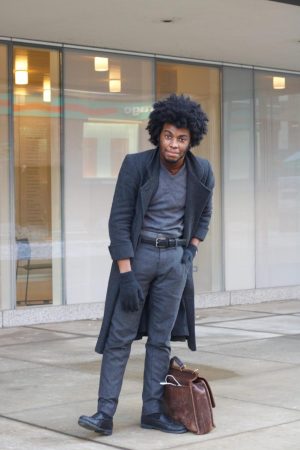
“As a kid, my parents always told me you have to be the best in order to get noticed,” Manson said. “This is still a sentiment that I subconsciously hold.”
What Manson isn’t able to receive in the halls of DePaul’s School of Music, she finds within Chicago’s music community.
“Black people hire Black people, so it’s very communal,” Manson said. “We all know each other really [well] and hire each other for the same gig. I kind of have a double life. Switching from being a Black musician at DePaul to just a musician like everyone else within the Black musician community.”
While Manson finds connections outside of DePaul, other DePaul students have become an important part of helping connect Black students and advance their careers. Lazarus Howell, a DePaul junior majoring in comedic arts, makes a point to be involved in multiple groups to help other students find community.
“I’m a comedy consultant and writer for a show called ‘Black Boy Joy’ that a DePaul alum helped connect me with,” Howell said. “I’m also President of Black Artists Today, Pickle Jar Comedy Collective and play in a band.”
Howell emphasizes the importance for Black students to try as many things as possible. He also says it’s important to grow the Black community at DePaul.
“For comedy arts, there’s only three Black people,” Howell said. “I think sometimes Black people don’t realize the things they can do. Sometimes these majors aren’t accessible to most Black people, in terms of the things that they can do. And that’s why we don’t have as much, but you know, we can change that just by being and by excelling and showing Black people that this is an option.”
DePaul has a Black Cultural Center where students can find groups related to their majors. Within the cultural center, some of the specific programs are the Better Black Business Series, Black Girls Break Bread X DePaul, Sankofa Black Student Formation Program and Black Artist Spotlight. DePaul also has student organizations like Black Student Union and Black Artists of Today and more.
Ajayi started creating her own characters in high school to help with her mental health.
“Qua is a combination of my two best friends at the time, I doodle him instead of harming myself,” Ajayi said. “He’s a really definite character in my life that I continue implementing in my artwork.”
Using art, she was able to find her passion as well as show it to others. This was just the start of Ajayi sharing her creations with the world.
“In high school, I used to sell shirts with my character Qua,” Ajayi said. “A lot of people bought it, which made me really happy to know something that is very close to my heart has an impact on somebody else.”
In 2020, Ajayi started selling more of her art, which is also displayed on her instagram @saintbunni. One of her most popular pieces was a drawing of a Black woman with the words “Black Lives Matter” displayed on top.
“The entire movement exemplified Black voices and created space for so many Black artists,” Ajayi said. “Since then, it feels like the movement has been diminishing, you don’t see them in the news and have to actively search.”
Ajayi is worried how the future of the Black Lives Matter movement will become after the pullback in the past year. She said it has been difficult to find other Black artists recently.
“It seemed like we were taking the right steps and now since there isn’t as much commotion,” Ajayi said. “Chicago has a great space for Black artists, but for a while, I haven’t seen anything but a surplus of white creators.”
Within the DePaul community, Ajayi hopes that it will go back to how it was previously with its Black community and supporting artists of color.
“If you’re gonna have such a dominant art program — in Chicago, no less — there should be more diversity and more accessibility for people to see it,” Ajayi said.
The future of art is creating spaces of diversity and opening up opportunities to Black and Brown artists. Manson feels the best way for students at DePaul to help is by supporting local artists and being intentional with other people.
“Support Black musicians, support Black artists and Black creators because they don’t get enough clout,” Manson said. “I think a lot of people fail to realize that we are multifaceted people and we are always going to be here.”


